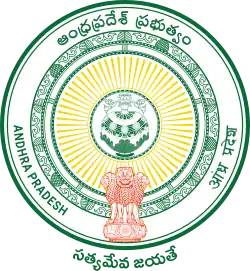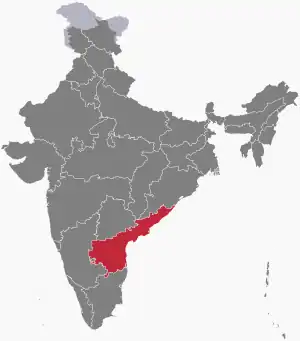Andhra Pradesh (English: /ˌɑːndrə prəˈdɛʃ/,[9] Telugu: [aːndʱrɐ prɐdeːʃ] ⓘ abbr. AP) is a state in the southern coastal region of India. It is the seventh-largest state with an area of 162,970 km2 (62,920 sq mi)[5] and the tenth-most populous state with 49,577,103 inhabitants.[4] It has shared borders with Chhattisgarh, Odisha, Karnataka, Tamil Nadu, Telangana and the Bay of Bengal. It has the second-longest coastline in India at about 974 km (605 mi).[5] After existence as Andhra State and unified Andhra Pradesh, the state took its present form on 2 June 2014, when the new state of Telangana was formed through bifurcation.[10] Amaravati is the capital of the state, with the largest city being Visakhapatnam. Water sharing disputes and asset division with Telangana are not yet resolved. Telugu, one of the classical languages of India used by the majority of people, is the first official language.
As per the 8th century BCE Rigvedic text Aitareya Brahmana, the Andhras left North India off the banks of the Yamuna river and migrated to South India. In the third century BCE, Andhra was a vassal kingdom of Ashoka of the Mauryan Empire. After his death, it became powerful and extended its empire to the whole Maratha country and beyond under the rule of the Satavahana dynasty. After that, the major rulers included the Pallavas, Eastern Chalukyas, Kakatiyas, Vijayanagara Empire, Qutb Shahi dynasty, Nizam dynasty, East India Company, and British Raj.
The Eastern Ghats are a major dividing line separating coastal plains and peneplains. The coastal plains are part of Coastal Andhra. These are mostly delta regions formed by the Krishna, Godavari, and Penna rivers. Peneplains are part of Rayaaseema. 60% of the population is engaged in agriculture and related activities. Rice is the state's major food crop and staple food. The state contributes 10% of total fish production and over 70% of shrimp production in India. Industry sectors such as food products, non-metallic minerals, textiles, and pharmaceuticals are the top employment providers. The automotive sector accounts for 10% of India's auto exports. The state has about one-third of India's limestone reserves, large deposits of baryte and galaxy granite, and reserves of oil and natural gas.[11] Satish Dhawan Space Centre (SDSC), known as Sriharikota Range (SHAR), at the barrier island of Sriharikota in Tirupati district, is the satellite launching station of India.
Some of the unique products from the state are Banaganapalle mangoes, Bandar laddu, Kondaplli toys, Tirupati laddu, and saris made in Dharmavaram and Machilipatnam. Kuchipudi is the official dance form. Many composers of Carnatic music, like Annamacharya, Kshetrayya, and Tyagaraja, were from this region. The Tirumala Venkateswara temple near Tirupati is the most visited Hindu religious place in the world. The state is home to a variety of other pilgrimage centres and natural attractions.
Etymology
Epigraphist Iravatham Mahadevan interprets the Sanskrit word 'āndʰra' as a corruption of the masculine nominative suffix '-anṟu' of Early Telugu language (c.800 BCE).[12]
According to the Sanskrit text Aitareya Brahmana (800–500 BCE), a group of people named Andhras left North India off the banks of the Yamuna and settled in South India.[13][14][15] The Satavahanas were mentioned by the names Andhra, Andhrara-jateeya, and Andhrabhrtya in the Puranic literature.[16][17] They did not refer to themselves as Andhra in any of their coins or inscriptions; it is possible that they were termed as Andhras because of their ethnicity or because their territory included the Andhra region.[18][19]
History
Early and medieval history
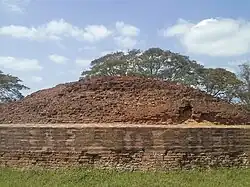 Ruins of the Buddhist Maha Stupa at Bhattiprolu, built during the 3rd century BCE–2nd century BCE
Ruins of the Buddhist Maha Stupa at Bhattiprolu, built during the 3rd century BCE–2nd century BCE Nagarjunakonda ruins, 3rd century CE
Nagarjunakonda ruins, 3rd century CE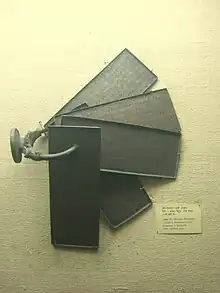 Sanskrit inscriptions written in Telugu on copper plates, dating to Eastern Chalukyas rule in 10th century CE
Sanskrit inscriptions written in Telugu on copper plates, dating to Eastern Chalukyas rule in 10th century CE Kondapalli Fort, 14th century CE
Kondapalli Fort, 14th century CE Lepakshi Nandi, 16th century CE
Lepakshi Nandi, 16th century CE
The Assaka mahajanapada, one of the sixteen Vedic mahajanapadas, included Andhra Pradesh, Maharashtra, and Telangana.[20] Archaeological evidence from places such as Bhattiprolu, Amaravati, Dharanikota, and Vaddamanu suggests that the Andhra region was part of the Mauryan empire. Amaravati might have been a regional centre under Mauryan rule. After the death of Emperor Ashoka, Mauryan rule weakened around 200 BCE and was replaced by several smaller kingdoms in the Andhra region.[21] One of the earliest examples of the Brahmi script, the progenitor of several scripts, including Telugu, comes from Bhattiprolu, where the script was used on an urn containing the relics of Buddha.[22]
The Satavahana dynasty dominated the Deccan plateau from the 1st century BCE to the 3rd century CE.[23] It had trade relations with the Roman Empire.[24] The later Satavahanas made Dharanikota, near Amaravati, their capital. According to the Buddhists, Nagarjuna, the philosopher of Mahayana, lived in this region.[25][26][27] The Andhra Ikshvakus, with their capital at Vijayapuri, succeeded the Satavahanas in the Krishna River valley in the latter half of the 2nd century.[28] The Salankayanas were an ancient dynasty that ruled the Andhra region between Godavari and Krishna with their capital at Vengi (modern Pedavegi) from 300 to 440 CE.[29] Telugu Cholas ruled present-day Rayalaseema from the fifth to the eleventh centuries from Cuddapa and Jammalamadugu. The Telugu inscription of Erikal Mutturaju Dhananjaya Varma, known as Erragudipadu sasanam, was engraved in 575 CE in the present Kadapa district. It is the earliest written record in Telugu.[30]
The Vishnukundinas were the first dynasty in the fifth and sixth centuries to hold sway over most of Andhra Pradesh, Kalinga, and parts of Telangana.[31] The Eastern Chalukyas of Vengi, whose dynasty lasted for around five hundred years from the 7th century until 1130 CE, eventually merged with the Chola dynasty. They continued to rule under the protection of the Chola dynasty until 1189 CE. [32] At the request of King Rajaraja Narendra, Nannaya, considered the first Telugu poet, took up the translation of the Mahabharata into Telugu in 1025 CE.[33]
Kakatiyas ruled this region and Telangana for nearly two hundred years between the 12th and 14th centuries. They were defeated by the Delhi Sultanate. Musunuri Nayaks and Bahamani Sultanate took over when Delhi Sultanate became weak. The Reddi kingdom ruled parts of this region in the early 14th century. They constructed Kondaveedu Fort and Kondapalli Fort. After their rule, Gajpathis and Bahmani sultans ruled this region in succession before this region, along with most of present-day Andhra Pradesh, became part of the Vijayanagar empire.[34][35][36]
The Vijayanagara empire originated on the Deccan plateau in the early 14th century. It was established in 1336 by Harihara Raya I and his brother Bukka Raya I of the Sangama dynasty, who served as treasury officers of the Kakatiyas of Warangal.[37] During their rule, the Pemmasani Nayaks controlled parts of Andhra Pradesh and had large mercenary armies that were the vanguard of the empire in the 16th century.[38] The empire's patronage enabled fine arts and literature to reach new heights in Kannada, Telugu, Tamil, and Sanskrit, while Carnatic music evolved into its current form.[39] The Lepakshi group of monuments built during this period have mural paintings of the Vijayanagara kings, Dravidian art, and inscriptions.[40] These are put on the tentative list of the UNESCO World Heritage Committee.[41]
Modern history

Following the defeat of the Vijayanagara empire, the Qutb Shahi dynasty held sway over Andhra Pradesh.[42] This region passed under the rule of the Nizams under the Mughal Empire. Soon, Nizam established himself as the sovereign ruler. In 1611, an English trading post by the name of "East India Company" was established in Masulipatinam on India's east coast.[43] In the early nineteenth century, Northern Circars was ceded to the British East India Company and became part of its Madras Presidency. Eventually, this region emerged as the Coastal Andhra region, the northern parts of which were later known as Uttarandhra. Later, the Nizam ceded five territories to the British, which eventually became the Rayalaseema region. The local chieftains, known as Poligars, revolted in 1800 against the company's rule, which was suppressed by the company. Raja Viziaram Raz (Vijayaram Raj) established a sovereign kingdom by claiming independence from the Kingdom of Jeypore in 1711. It formed alliances with the French and British East India Companies to conquer the neighbouring principalities of Bobbili, Kurupam, Paralakhemundi, and the kingdom of Jeypore. It fell out with the British and, as a result, was attacked and defeated in the battle of Padmanabham. It was annexed as a tributary estate like other principalities and remained so until their accession to the Indian Union in 1949.[44]
Following the Indian rebellion of 1857, the British crown ruled this region, until India became independent in 1947. The No Tax Campaign in Chirala and Perala in 1919, led by Duggirala Gopalakrishnayya, the Rampa Revolt led by Alluri Sitarama Raju in 1921, and the Salt Satyagraha in Dendulur in 1930 are some of the protests against British rule.re Tanguturi Prakasam was arrested and jailed for more than three years for participating in the Quit India movement of 1942. He served as prime minister of the Madras presidency in 1946–47.[45]
Dowleswaram Barrage, built in 1850 by Arthur Cotton, brought unused lands in the Godavari river basin into cultivation and transformed the economy of the region.[46] Charles Philip Brown did pioneering work in transforming Telugu to the print era and introduced Vemana poems to English readers.[47] Kandukuri Veeresalingam is considered the father of the Telugu Renaissance Movement, as he encouraged the education of women and the remarriage of widows and fought against child marriage and the dowry system.[48] Gurajada Apparao, a pioneering playwright who used spoken dialect, wrote the play Kanyasulkam in 1892. It is considered the greatest play in the Telugu language.[49]
Post-independence
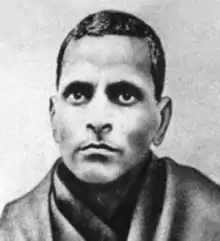 Potti Sreeramulu, whose fast unto death in 1952 led to the formation of Andhra State
Potti Sreeramulu, whose fast unto death in 1952 led to the formation of Andhra State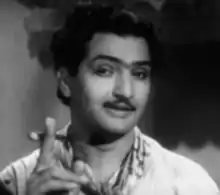 NT Rama Rao, a film actor, who became chief minister of Andhra Pradesh in 1983
NT Rama Rao, a film actor, who became chief minister of Andhra Pradesh in 1983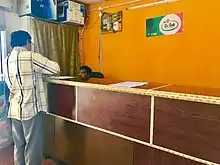 Mee Seva office (initial launch of the E-Seva Project in 2001)
Mee Seva office (initial launch of the E-Seva Project in 2001)
In an effort to gain an independent state based on linguistic identity and to protect the interests of the Telugu-speaking people of Madras State, Potti Sreeramulu fasted to death in 1952. The Telugu-speaking area of Andhra State was carved out of Madras State on 1 October 1953, with Kurnool as its capital city. Tanguturi Prakasam became the first chief minister. On the basis of the Gentlemen's Agreement of 1956, the States Reorganisation Act created Andhra Pradesh by merging the neighbouring Telugu-speaking areas of the Hyderabad State with Hyderabad as the capital on 1 November 1956.[50]
The Indian National Congress (INC) ruled the state from 1956 to 1982. Neelam Sanjiva Reddy became the first chief minister. Among Congress chief ministers, P. V. Narasimha Rao is known for implementing land reforms and land ceiling acts and securing reservation for lower castes in politics.[51] In 1983, the Telugu Desam Party (TDP) won the state elections, and N. T. Rama Rao became the chief minister of the state for the first time after launching his party just nine months earlier.[52] This broke the long-time single-party monopoly enjoyed by the INC. He transformed the sub-district administration by forming mandals in place of earlier taluks, removing hereditary village heads, and appointing non-hereditary village revenue assistants.[53] Nara Chandrababu Naidu, Rao's son-in-law, came to power in 1995 with the backing of a majority of the MLAs. He introduced e-governance by launching e-Seva centres in 2001 for paperless and speedy delivery of government services. He is credited with transforming Hyderabad into an IT hub by providing incentives for tech companies to set up centres.[54] In 2004, Congress returned to power with a new chief ministerial face, YS Rajashekara Reddy, better known as YSR. The main emphasis during Reddy's tenure was on social welfare schemes such as free electricity for farmers, health insurance, tuition fee reimbursement for the poor, and the national rural employment guarantee scheme. He was elected chief minister again but was killed in a helicopter crash that occurred in September 2009. [55]
During its 58 years as a unified state, the state weathered separatist movements from Telangana (1969) and Andhra (1972) successfully.[56] A new party called Telangana Rashtra Samithi, formed in April 2001 by Kalvakuntla Chandrashekar Rao (KCR), reignited the Telanganga movement. When the central government decided to initiate the process to form an independent Telangana in December 2009, Samaikyandhra movement to keep the state united took shape. The agitations continued for nearly 5 years, with the Telangana side led by Telangana Joint Action Committee[57] harping on the marginalisation of food, culture, language, and unequal economic development and the Samaikyandhra movement focusing on the shared culture, language, customs, and historical unity of Telugu-speaking regions.[58] The Andhra Pradesh Reorganisation Act bill was passed by the parliament of India for the formation of the Telangana state, comprising ten districts, despite opposition by the state legislature.[59] The new state of Telangana came into existence on 2 June 2014 after approval from the president of India, with the residual state continuing as Andhra Pradesh.[60]
In the final elections held in the unified state in 2014, the TDP got a mandate in its favour, defeating its nearest rival, the YSR Congress Party, a breakaway faction of the Congress founded by Y. S. Jagan Mohan Reddy, son of former Chief Minister Y. S. Rajasekhara Reddy. N. Chandrababu Naidu, the chief of the TDP, became the chief minister on 8 June 2014.[61] In 2017, the government of Andhra Pradesh began operating from its new greenfield capital, Amaravati, for which 33,000 acres were acquired from farmers through an innovative land pooling scheme.[62][63] Interstate issues with Telangana relating to the division of assets of public sector institutions and organisations of the united state and the division of river waters are not yet resolved.[64][65]
Geography
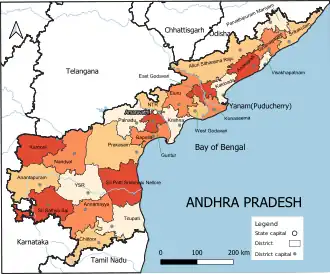 Andhra Pradesh political map with neighbours
Andhra Pradesh political map with neighbours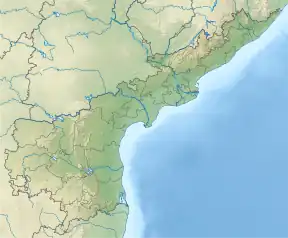 Andhra Pradesh relief map
Andhra Pradesh relief map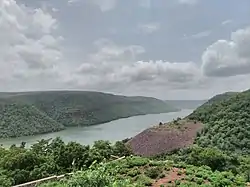 Krishna River gorge at Srisailam
Krishna River gorge at Srisailam Godavari river at Papi Hills near Rajamahendravaram
Godavari river at Papi Hills near Rajamahendravaram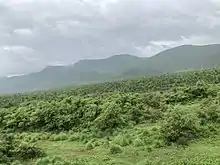 Eastern Ghats near Kadapa
Eastern Ghats near Kadapa
The state is bordered by Telangana to the north and west, Chhattisgarh and Orissa to the north, the Bay of Bengal to the east, Tamil Nadu to the south, and Karnataka to the west. Yanam district, an enclave of Puducherry, is in the state bordering Kakinada district.[66] It has a coastline of around 974 kilometres (605 mi), which makes it the second-longest coastline in the nation.[5]
The Eastern Ghats are a major dividing line separating coastal plains and peneplains in the state's geography. The Eastern Coastal Plains comprise the area of coastal districts up to the Eastern Ghats as their border along the Bay of Bengal, with variable width. These are, for the most part, delta regions formed by the Krishna, Godavari, and Penna rivers. Most of the coastal plains are put to intensive agricultural use. The Eastern Ghats are discontinuous, and individual sections have local names. The ghats become more pronounced towards the south and extreme north of the coast. These consist of the Papikonda range, the Simhachal hill range, the Yarada hills, the Nallamala Hills, the Papi hills, the Seshachala hills, and the Horsley hills. The Kadapa Basin,[67] formed by two arching branches of the Eastern Ghats, is a mineral-rich area. Peneplains, part of Rayalaseema, slope towards the east, with the Eastern Ghats as their eastern border.[68]
Flora and fauna

The total forest cover of the state is 29,784.3 square kilometres (11,499.8 sq mi), amounting to 18.28% of the total area.[69] The Eastern Ghats region is home to dense tropical forests, while the vegetation becomes sparse as the ghats give way to the peneplains, where shrub vegetation is more common. The vegetation found in the state is largely of dry deciduous types, with a mixture of teak, Terminalia, Dalbergia, Pterocarpus, Anogeissus, etc. The state possesses some rare and endemic plants like Cycas beddomei, Pterocarpus santalinus, Terminalia pallida, Syzygium alternifolium, Shorea talura, Shorea tumburgia, Psilotum nudum, etc.[70] Coringa is an example of mangrove forests and salt-tolerant forest ecosystems near the sea. The area of these forests is 582 km2 (225 sq mi), accounting for about 9% of the local forest area of the state.[71]
The diversity of fauna includes tigers, leopards, Dholess, black bucks, cheetals, sambars, sea turtles, and a number of birds and reptiles. The estuaries of the Godavari and Krishna rivers support rich mangrove forests with fishing cats and otters as keystone species.[70] The state has many sanctuaries and national parks, such as Coringa, Nagarjunsagar-Srisailam Tiger Reserve, Kolleru Bird Sanctuary, and Nelapattu Bird Sanctuary.[72]
Mineral resources

The state, with its varied geological formations, contains a variety of industrial minerals and building stones. It is listed at the top of the list of mica deposits in India. Minerals found in the state include limestone, manganese, asbestos, iron ore, ball clay, fire clay, gold, diamonds, graphite, dolomite, quartz, tungsten, steatitic, feldspar, and silica sand. It has reserves of oil and natural gas. It has about one-third of India's limestone reserves and is known for large exclusive deposits of baryte and galaxy granite.[73] The largest reserves of uranium are in Tummalapalli village, Vemula mandal, of YSR district.[74]
Climate
The climate varies considerably, depending on the geographical region. Summers last from March to June. In the coastal plain, the summer temperatures are generally higher than in the rest of the state, with temperatures ranging between 20 and 41 °C (68 and 106 °F). July to September is the season for tropical rains from the southwest monsoon. During October to December, low-pressure systems and tropical cyclones form in the Bay of Bengal along with the northeast monsoon, bringing rains to the southern and coastal regions of the state. November to February are the winter months. Since the state has a long coastal belt, the winters are not very cold. The range of winter temperatures is generally 12 to 30 °C (54 to 86 °F). Lambasingi in Visakhapatnam district is nicknamed the "Kashmir of Andhra Pradesh" as its temperature ranges from 0 to 10 °C (32 to 50 °F).[75][76] The normal rainfall for the state is 966 mm (38.0 in), and the actual rainfall for June 2020–May 2021 was 1,191 mm (46.9 in).[77]
Demographics
Based on the 2011 Census of India, the population of Andhra Pradesh is 49,577,103, with a density of 304/km2 (790/sq mi). 70.53% of the population is rural, and 29.47% is urban.[5] The state has 17.08% Scheduled Caste and 5.53% Scheduled Tribe populations.[78] Children in the age group of 0–6 years number 5,222,384, constituting 10.6% of the total population. Among them, 2,686,453 are boys and 2,535,931 are girls. Adults in the age group of 18–23 account for 5,815,865 (2,921,284 males, 2,894,581 females).[79]
The state has a sex ratio of 997 females per 1000 males, higher than the national average of 926 per 1000. The literacy rate in the state stands at 67.35%. Erstwhile West Godavari district has the highest literacy rate of 74.32%, and erstwhile Vizianagaram district has the least with 58.89%.[5] The state ranks 27th of all Indian states in the Human Development Index (HDI) scores for the year 2018.[80] As of 1 January 2023, there are 39,984,868 voters (19,759,489 males, 20,221,455 females, and 3,924 third-gender voters). Kurnool district has the maximum number of voters at 1,942,233, while ASR district has the minimum at 729,085.[81]
Languages of Andhra Pradesh[lower-alpha 1] (2011)[82]
Telugu is the first official language, and Urdu is the second official language of the state.[6] Telugu is the mother tongue of nearly 90% of the population. Rajahmundry is the cultural capital of Andhra Pradesh, as the Telugu language has roots from this region.[82][83][84] Urdu, spoken by about 6% of the population, was a second official language in fifteen districts of united Andhra Pradesh[85] and was made the second official language on 17 June 2022.[7]
Tamil, Kannada, and Odia are spoken in the border areas. Lambadi, Koya, Savara, Konda, Gadaba, and a number of other languages are spoken by the Scheduled Tribes of the state.[86] 19% of the population aged 12+ years has the ability to read and understand English, as per the IRS Q4 2019 survey.[87]
According to the 2011 census, the major religious groups in the state are Hindus (90.89%), Muslims (7.30%), and Christians (1.38%).[lower-alpha 2][88]
The National Family Health Survey (NFHS-5) 2019–21 data provides an insight into the economic and health status of households. 85% of households in the state have pucca houses. 76% of households (59% urban, 83% rural) own a house. Almost all houses have an electricity connection. 84% of households use clean fuel for cooking. 22% have piped water. 85% of all households (urban areas 97%, rural areas 80%) have access to a toilet facility. Almost all urban households (96%) and most rural households (89%) use a mobile phone. 96% of households use bank or post office savings accounts. 97% of childbirths during 2014–2019 happened in a health facility. The state health insurance scheme (Dr. YSR Arogya Sri), the employee health scheme, the Rashtriya Swasthya Bima Yojana (RSBY), the employees' state insurance scheme (ESIS), and the central government health scheme cover 70% of households with at least one member covered.[89]
Administrative divisions
Andhra Pradesh comprises two regions, namely Kostaandhra (Coastal Andhra) and Rayalaseema. The northern part of Coastal Andhra is sometimes mentioned separately as Uttaraandhra, particularly after the bifurcation to raise voice against underdevelopment.[90]
Districts

The state is further divided into 26 districts, with Uttarandhra comprising 6 districts, Kostaandhra comprising 12 districts, and Rayalaseema comprising 8 districts.[91] These districts are made up of 76 revenue divisions,[92] 679 mandals[92] and 13,324 village panchayats as part of the administrative organisation.[93]
Uttaraandhra:
Kostaandhra:
Rayalaseema:
Cities and towns
There are 123 urban local bodies, comprising 17 municipal corporations, 79 municipalities, and 27 nagar panchyats, in the state. The urban population is 149 million as per the 2011 census.[94] There are two cities with more than one million inhabitants, namely Visakhapatnam and Vijayawada.[95]
| Ciy/Town | District(s) post 2022 reorg | Population (2011) |
|---|---|---|
| Visakhapatnam | Visakhapatnam, Anakapalli | 1,728,128 |
| Vijayawada | NTR | 1,476,931 |
| Guntur | Guntur | 743,354 |
| Nellore | Nellore | 558,548 |
| Kurnool | Kurnool | 484,327 |
| Rajahmundry | East Godavari | 560,756 |
| Tirupati | Tirupati | 461,900 |
| Kakinada | Kakinada | 443,028 |
| Kadapa | YSR | 344,893 |
| Anantapur | Anantapur | 340,613 |
Economy
GSDP at current prices for the year 2022–23 is estimated at ₹1,317,728 crore (US$170 billion) (advanced estimates) against ₹1,133,837 crore (equivalent to ₹12 trillion or US$150 billion in 2023) (first revised estimates) for the year 2021–22. The share of agriculture's contribution to the GSDP is at 36.19%, while industry is at 23.36%, and services are at 40.45%. The state posted a record growth of 7.02% at constant prices (2011–12) against the country's growth of 7%. GDP per capita is estimated at ₹219,518 (US$2,700).[5][96] AP achieved an overall 4th rank in the Sustainable Development Goals (SDG) India Report for the year 2020–21, with a first rank in SDG-7 (affordable energy) and a second rank in SDG-14 (life below water).[97]
In 2014–15, the first year after bifurcation, the state ranked eighth in GSDP at current prices, which stood at ₹520,030 crore (equivalent to ₹7.8 trillion or US$98 billion in 2023). It recorded 12.03% growth compared to the previous fiscal, which was ₹464,184 crore (equivalent to ₹7.4 trillion or US$93 billion in 2023).[98][99]
Agriculture

The agricultural economy comprises agriculture, livestock, poultry farming, and fisheries.[77] Four important rivers in India, the Godavari, Krishna, Penna, and Tungabhadra, flow through the state and provide irrigation. 60% of the population is engaged in agriculture and related activities. Rice is the state's major food crop and staple food. The state has three agricultural export zones: the undivided Chittoor district for mango pulp and vegetables, the undivided Krishna district for mangoes, and the undivided Guntur district for chillies.[100] Besides rice, farmers grow jowar, bajra, maize, minor millet, many varieties of pulses, oil seeds, sugarcane, cotton, chilli pepper, mango, and tobacco. Crops used for vegetable oil production, such as sunflower and peanuts, are popular.[101]
The state contributes 10% of total fish production and over 70% of shrimp production in India.[102] The geographical location of the state allows marine fishing as well as inland fish production. The most exported marine products include Vannamei shrimp.[103]
Industries
 Aerial view of Hindustan Shipyard Limited (HSL), Visakhapatnam
Aerial view of Hindustan Shipyard Limited (HSL), Visakhapatnam Isuzu Motors India manufacturing plant aerial view, Sri City
Isuzu Motors India manufacturing plant aerial view, Sri City
As per the annual survey of industries 2019–20, the number of factories was 12,582 with 681,224 employees. The top 4 employment providers are food products (25.48%), non-metallic minerals (11.26%), textiles (9.35%), and pharmaceuticals (8.68%). Gross value added (GVA) contributed by the industrial sector is ₹55,035 crore (US$6.9 billion), of which food products (18.95%), pharmaceuticals (17.01%), and non-metallic minerals (16.25%) are the top 3 contributors. From a district perspective, the top three districts were undivided Visakhapatnam, Chittoor, and Krishna.[104]
The defence administered Hindustan Shipyard Limited built the first ship in India in 1948.[105] Sri City, located in Tirupati district, is an integrated business city that is home to several multinational companies.[106] The state has 36 big auto players, such as Ashok Leyland, Hero Motors, Isuzu Motors India, and Kia Motors, with investments of over US$2.8 billion. It accounts for 10% of India's auto exports.[107]
Industrial minerals, dimensional stones, building materials, and sand are the main minerals. The mining sector contributed ₹3,390 crore (US$420 million) in revenue to the state during 2021–22.[108] As of April 2023, Ravva Block, in the shallow offshore area of the Krishna Godavari Basin, had produced nearly 311 million barrels of crude oil and 385 billion cubic feet of natural gas since its initial production in March 1994.[109] The state accounts for 2.7% of crude oil production in India, with 827.8 thousand metric tonnes from its Krishna Godavari basin.[110] 809 million metric standard cubic metres of natural gas are produced from onshore sites, which accounts for 2.4% of India's production.[111]
Services

The value of information technology exports from the state in 2021–22 was ₹926 crore (US$120 million), which is 0.14% of the IT exports from India. Exports have remained below 0.2% in the past five years.[112]
The state is ranked third in domestic tourist footfalls for the year 2021, with 93.2 million domestic tourists, which amounts to 13.8% of all domestic tourists in India. A major share of the tourists visit temples in Tirupati, Vijayawada, and Srisailam.[113]
Government and politics

The legislative assembly is the lower house of the state with 175 members, and the legislative council is the upper house with 58 members. In the Parliament of India, the state has 11 seats in the Rajya Sabha and 25 seats in the Lok Sabha.[114] There are a total of 175 assembly constituencies in the state.[115][116]
In the 2019 elections, Y. S. Jagan Mohan Reddy, leader of the YSR Congress Party, became the chief minister with a resounding mandate by winning 151 out of 175 seats.[117]
Government revenue and expenditure
For 2021–22, total receipts of the Andhra Pradesh government were ₹2.05 lakh crore (US$26 billion), inclusive of ₹53,284 crore (US$6.7 billion) of loans. States' own tax revenue was ₹70,979 crore (US$8.9 billion). The top three sources of non-tax revenue are state goods and services tax (GST) (₹23,809 crore (US$3.0 billion)), sales tax/value added tax (VAT) (₹20,808 crore (US$2.6 billion)), and state excise (₹14,703 crore (US$1.8 billion)).[96] The government earned a revenue of ₹7,345 crore (US$920 million) from 2.574 million transactions for registration services. Visakhapatnam, Vijayawada, Guntur, and Tirupati are the top contributors to the revenue.[118]
The government's total expenditure was ₹1,91,594 crore, which includes debt repayment of ₹13,920 crore. The fiscal deficit was ₹25,013 crore, which was 2.1% of the GSDP. Revenue expenditure was ₹1,59,163 crore and capital expenditure was ₹16,373 crore. Welfare expenditures got the maximum share. Education accounted for ₹25,796 crore, energy ₹10,852 crore, and irrigation ₹7,027 crore.[96]
Outstanding debt was ₹3.89 lakh crore, an increase of almost ₹40,000 crore compared to the previous year. This accounts for 32.4 per cent of the GSDP.[119] The outstanding guarantee estimate was ₹1,38,875 crore, of which ₹38,473 are for the power sector, which equals 12% of GSDP.[96]
Amaravati protests
In August 2020, the Andhra Pradesh legislative assembly passed the Andhra Pradesh decentralisation and inclusive development of all regions act. It provided for limiting Amaravati as legislative capital while naming Vizag as executive capital and Kurnool as judicial capital.[120] The events leading to this decision resulted in widespread and continuing protests by the farmers of Amaravati.[121] The act has been challenged in the Andhra Pradesh High Court, which ordered to maintain status quo until the court completes its hearing. The government, led by Y. S. Jagan Mohan Reddy, withdrew the act when the High Court hearing reached the final stage. The chief minister said that his government would bring a better and more complete bill.[122] The protesters under the banner of Amaravati Parirakshana Samithi (APS) and the Joint Action Committee (JAC) of Amaravati received support from all the political parties barring the ruling YCP when they held their long marches across the state seeking support for their agitation.[123]
On 3 March 2022, the High Court ruled that the government could not abandon the development of Amaravati as the capital city after farmers parted with 33,000 acres of land against the agreement with Andhra Pradesh Capital Region Development Authority (APCRDA) to develop it as the capital city and ₹15,000 crore was sunk in it over development expenditure. It asked the government to develop Amaravati within six months.[124] When the government appealed to the Supreme Court, it got a stay on the judgement regarding developing the city within six months. The Supreme Court is set to hear it in December 2023, following its decision on 11 July 2023.[125]
Interstate disputes
Assets division with Telangana
There are 91 institutions under schedule IX with assets of ₹1.42 lakh crore, 142 institutions under schedule X with assets of ₹24,018.53 crore, and another 12 institutions not mentioned in the act with assets of ₹1,759 crore, which are to be split between Andhra Pradesh and Telangana following the bifurcation. An expert committee headed by Sheela Bhide gave a recommendation for bifurcation of 89 out of the 91 schedule IX institutions. Telangana selectively accepted the recommendations, while Andhra Pradesh asked for their acceptance in total. The division of the RTC headquarters and the Deccan Infrastructure and Landholdings Limited (DIL) with huge land parcels has become contentious. Despite several meetings of the trilateral dispute resolution committees, no progress was made. The Andhra Pradesh government filed a suit in the Supreme Court.[64]
Krishna river water sharing dispute
Andhra Pradesh and Telangana continue to dispute the water share of the Krishna River. In 1969, the Bachawat tribunal for the allocation of water shares among the riparian states allocated 811 tmcft of water to Andhra Pradesh. The Andhra Pradesh government of that time split it in a 512:299 tmcft ratio between Andhra Pradesh (including the basin area of Rayalaseema) and Telangana, respectively. It was based on the utilisation facilities established at that time. Though the tribunal recommended the use of the Tungabhadra Dam (a part of the Krishna Basin) to provide water to the drought-prone Mahabubnagar area of Telangana, this was not implemented. The bifurcation act advised the formation of the Krishna River Management Board (KRMB) and the Godavari River Management Board (GRMB) for resolving disputes between the new states. In 2015, the two states agreed to share water in the 66:34 (AP:Telangana) ratio as an interim arrangement in a meeting with the central water ministry, which is to be reviewed every year. This practice continued without further review. Telangana filed a suit in the Supreme Court for a 70% share. Following the assurance of the formation of a tribunal to resolve the issue, Telangana withdrew its suit. The centre has yet to form the tribunal.[65]
Godavari water sharing dispute
Andhra Pradesh got 1172.78 tmcft of Godavari water. Telangana is utilising 433 tmcft for its completed projects, while Andhra Pradesh's share is 739 tmcft. The Andhra Pradesh government has opposed Telangana submitting a detailed project report for additional utilisation through new or upgraded projects such as Kaleswaram, Tupakulagudem, Sitarama, Mukteswaram, and Modikunta lift irrigation projects.[126]
Five villages near Bhadrachalam
The 1.50-metre increase in the height of the Polavaram coffer dam to 44 metres raised the suspicion that it led to flooding of Bhadrachalam and nearby villages in Telangana along the Godavari river in 2022. Three mandals that were originally part of Andhra State were transferred back to Andhra Pradesh, excluding Bhadrachalam town, to support the Polavaram project, as those areas are likely to be submerged. Telangana would like to take back five villages on the river banks for ease of movement of its government machinery to provide rehabilitation support to its other villages beyond them, to which the Andhra Pradesh government is objecting.[127]
Infrastructure
Transport
Roads

The state has a total major road network of 47,244.83 km (29,356.58 mi). This comprises 8,163.72 km (5,072.70 mi) of national highways, 12,595.60 km (7,826.54 mi) of state highways, and 26,485.51 km (16,457.33 mi) of major district roads.[128] NH 16, with a highway network of around 1,000 km (620 mi) in the state, is a part of the Golden Quadrilateral project undertaken by the National Highways Development Project. The proposed Anantapuram–Amaravati Expressway is changed to Anantapur–Guntur national highway 544D, with implementation expected to begin in January 2023.[129]
1.828 million transport vehicles and 13.7 million non-transport vehicles are registered in the state. In the transport category, 0.98 million are goods carriages, constituting 53.61%; 0.66 million are auto rickshaws, constituting 36.21%; and 0.109 million are cabs, constituting 5.96%. In the non-transport category, 12.2 million are motorcycles, constituting 89.5%, and 1.067 million are four-wheelers, constituting 7.29%. [130] The integrated road accident database project, an initiative of the Ministry Of Road Transport and Highways (MORTH) is under implementation in the state. Construction of the Institute of Driver Training and Research Facilities at Darsi, Praksam district, and Dhone, Nandyal district, in partnership with Maruti Suzuki and Ashok Leyland, respectively, is in progress.[131] Automation of driving test tracks in nine district capitals is expected to be completed by 31 March 2023.[132]
The state government-owned Andhra Pradesh State Road Transport Corporation (APSRTC) is the public bus transport provider. It is split into 129 depots across four zones. It has a fleet strength of 11,098 buses and a staff count of 49,544. It operates 1.11 billion kilometres and serves 3.68 million passengers daily.[133] Pandit Nehru Bus Station (PNBS) in Vijayawada is the second-largest bus terminal in Asia.[134]
Railways

Andhra Pradesh has a total broad-gauge railway route of 3,969 km (2,466 mi).[135] The rail density of the state is 24.36 km per 1000 square kilometres. The railway network in Andhra Pradesh is under the South Central Railway, East Coast Railway, and South Western Railway zones.[136][137][138]
During 2014–2022, 350 km of new lines were constructed at a rate of 44 km per year in Andhra Pradesh under the South Central Railway division. The rate of construction was only 2 km per year in the preceding five years.[139] The Nadikudi–Srikalahasti line of 308.70 km sanctioned at a budget of ₹22.89 billion (US$290 million) in 2011–12 as a joint project of the centre and state is progressing slowly, with only phase 1 of 46 km between New Piduguralla station and Savalyapuram completed in 2021–22.[140]
There are three A1 and 23 A-category railway stations in the state, as per the assessment in 2017.[141] Visakhapatnam has been declared the cleanest railway station in the country, as per the assessment in 2018.[142] The railway station in Shimiliguda was the first highest broad gauge railway station in the country in terms of altitude.[143]
A new railway zone South Coast Railway Zone (SCoR), with headquarters in Visakhapatnam, was announced as the newest railway zone of the Indian Railways in 2019, but is yet to be implemented as of May 2023.[144]
Airports
Visakhapatnam Airport, NTR Amaravati international Airport, and Tirupati Airport are international airports in the state. The state has three domestic airports, namely Rajahmundry airport,Kadapa airport, and Kurnool airport.[145] A privately owned airport for emergency flights and chartered flights is at Puttaparthi.[146]
Sea ports

The state has one major port at Visakhapatnam under the administrative control of the central government and 15 notified ports, including three captive ports, under the control of the state government.[147][148] The other famous ports are Krishnapatnam Port, Gangavaram Port, and Kakinada Port. Gangavaram port is a deep seaport that can accommodate ocean liners up to 200,000–250,000 DWT.[149]
Communication
The AP statewide area network (APSWAN) connects 2,164 offices of state administration at 668 locations down to the level of mandal headquarters. The network supports both data and video communications. Bharat Sanchar Nigam Limited (BSNL) and the National Knowledge Network (NKN) link district headquarters with state headquarters with a bandwidth of 34 Mbit/s. Mandal headquarters are connected with a bandwidth of 8 Mbit/s.[150][151]
Andhra Pradesh State FiberNet Limited (APSFNL) operates an optical fibre network. This provides internet connectivity, telephony, and Internet protocol television (IPTV) with fibre to private and corporate users in Andhra Pradesh.[152]
Water
The state has 40 major and medium rivers and 40,000 minor irrigation sources. Godavari, Krishna, and Pennar are the major rivers. The total cultivable area is 19.904 million acres. Major, medium, and minor irrigation projects irrigate 10.311 million acres.[153] The Polavaram project under construction suffered setbacks with damage to its diaphragm wall during the 2022 floods.[154] The Veligonda project is likely to be commissioned by September 2023.[155] The Annamayya project, washed away in the 2021 floods, is set to be redesigned at a cost of 787 crore.[156][157]
Power

Thermal, hydel and renewable power plants supply power to the state. The installed capacity share of the state in the public sector generating stations was 7,245 MW. Private sector installed capacity was 9,370 MW, which includes independent power producer capacity of 1,961 MW. The total installed capacity was 16,615 MW. Peak power demand for the state in 2021–22 was 12,032 MW and per capita consumption was 1,285 kilowatt hours. The energy consumed is 68972 million units.[158]
Healthcare
The government is spending 7.3% of the state budget on healthcare, compared to an average of 4 to 4.5 per cent overall in the country.[159] The 108 service provides fast emergency management services by shifting patients to a nearby healthcare facility. The 104 service provides health care services at the doorstep of villages through mobile medical units that visit at least once a month.[160]
All the poor families are covered by the free state health insurance scheme called Arogyasri up to a limit of ₹500,000 (US$6,300). The services are provided in government and private hospitals under the network. During 2014–2018, though the nominal mean claim amount of Arogyasri beneficiaries went up significantly, it decreased after accounting for inflation. Mortality rates have significantly decreased, which indicates better outcomes are being achieved at a lower cost.[161]
Education
 Primary school in Ganti Pedapudi, Konaseema district
Primary school in Ganti Pedapudi, Konaseema district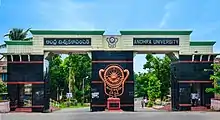
.jpg.webp)


Primary and secondary school education is imparted by government-aided and private schools, managed and regulated by the School Education Department of the state.[162][163] There are urban, rural, and residential schools.[164] As per the child info and school information report (2018–19), there were a total of 7,041,568 students[165] enrolled in 62,063 schools.[166] 605,052 students have appeared for the April 2023 Secondary School Certificate (SSC) exam in the regular stream. The overall pass percentage was 72.26%, with 100% in 933 schools.[167] In March–April 2023, 379,758 students appeared for intermediate second-year examinations. 272,001 candidates, amounting to 71%, were declared passed.[168]
The state initiated education reforms in 2020 by creating six types of schools: satellite foundation schools (pre-primary), foundational schools (pre-primary – class II), foundational school plus (pre-primary – class V), pre-high school (class III – class VII/VIII), high school (class III – class X), and high school plus (class III – class XII).[169] The transition to English-medium education in all government schools started in the academic year 2020–2021 and is expected to reach completion by 2024–25. 1000 government schools are affiliated to the CBSE in the years 2022–23 as an initial step, and the bilingual text book scheme was adopted to ease the transition.[170] The state government is going ahead with the English medium based on the parents survey despite protests and court cases.[171] The state initiative is being funded in part by a loan from the World Bank to the tune of $250 million over 2021–2026 through the "Supporting Andhra's Learning Transformation" (SALT) project to improve the learning outcomes of children up to class II level.[172]
There were 510 industrial training institutes (ITI) in the year 2020–21 in Andhra Pradesh, with 82 under government management and 417 under private management. The total available seats in 2021 were 93,280, out of which 48.90% were filled. 10,053 students completed ITI education in the year 2020.[173]
There are 169 government-aided degree colleges and 55 private-aided degree colleges in the state. 66 government colleges and 48 private-aided colleges have valid NAAC grades. There are 85 government-aided and 175 private polytechnic colleges with a sanctioned strength of 75,906 students.[174] The AP State Council of Higher Education organises various entrance tests for different streams and conducts counselling for admissions.[175] The AP State Skill Development Corporation is set up to support skill development and placement for the educated.[176]
There are a total of 36 universities, which comprise 3 central universities, 23 state public universities, 6 state private universities, and 4 deemed universities.[177] Andhra University is the oldest of the universities in the state, established in 1926.[178][179] The government established Rajiv Gandhi University of Knowledge Technologies (RGUKT) in 2008 to cater to the education needs of the rural youth of Andhra Pradesh.[180] Dr. Y.S.R University of Health Sciences oversees medical education in 348 affiliated colleges spanning the entire range from traditional medicine to modern medicine.[181] The public universities, including the legacy universities such as Andhra, Sri Venkateswara, and Nagarjuna, are suffering from a severe fund crunch and staff shortage, managing with only 20% of sanctioned full-time staff.[182] The Gross Enrolment Ratio (GER) in higher education for the age group 18–23 for the state is at 35.2% for the year 2019–20, which compares favourably with the GER for all of India at 27.1%. With a female GER of 35.3 and a male GER of 38.2, the Gender Parity Index is 0.84. The corresponding ratio for India is 1.01.[183]
Koneru Lakshmaiah Education Foundation University (KL College of Engineering) bagged the 50th rank, while Andhra University in Visakhapatnam bagged the 76th rank in the overall category of India rankings for 2023 as per the National Institute Ranking Framework (NIRF) of the Union Ministry of Education. 2,478 institutions, including 242 institutions from the state, participated in the ranking.[184]
Andhra Pradesh has 2,510 public libraries, including 4 regional libraries and 13 district central libraries under government management.[185] Saraswata Niketanam at Vetapalem in Bapatla district, one of the oldest libraries established under private management in 1918, is losing its attraction as the Internet spreads.[186] The government is planning to develop digital libraries at the village panchayat level.[187]
Science and technology

As of 20 June 2023, there are 190 science and technology organisations in Andhra Pradesh, including 12 central labs and research institutions.[188] Satish Dhawan Space Centre (SDSC), known as Sriharikota Range (SHAR), on the barrier island of Sriharikota in Tirupati district, is a satellite launching station operated by the Indian Space Research Organisation.[189] It is India's primary orbital launch site. India's lunar orbiter Chandrayaan-1 was launched from the centre on 22 October 2008.[190]
Some notable scientists
Yellapragada Subba Rao, a pioneering biochemist hailing from the state, discovered the function of adenosine triphosphate (ATP) as an energy source in the cell and developed drugs for cancer and filariasis.[191][192] Yelavarthy Nayudamma, a chemical engineer, worked extensively for the Central Leather Research Institute in Chennai and rose to become the director general of the Center for Scientific and Industrial Research (CSIR), India.[193] C. R. Rao is an Indian-American mathematician and statistician and an alumnus of Andhra University. His work on statistics influenced various sciences.[194]
Media

The total number of registered newspapers and periodicals in the state for the years 2020–21 was 5,798. There were 1,645 dailies, 817 weeklies, 2,431 monthlies, and 623 fortnightlies. 787 Telugu dailies had a circulation of 9,911,005. 103 English dailies had a circulation of 1,646,453.[195][196] Eenadu, Sakshi, and Andhra Jyothi are the top 3 Telugu daily newspapers widely published in Andhra Pradesh in terms of circulation and the top 3 Telugu news sites.[197][198] BBC Telugu News was launched on 2 October 2017.[199][200] Several privately owned news media outlets are considered biased towards specific political parties in the state.[201][202]
There were 10 general entertainment channels, 23 news channels, 2 health channels, 6 religious channels, 2 other channels, and 2 cable distribution channels, for a total of 45 channels empanelled by the Andhra Pradesh Information and Public Relations Department.[203] All India Radio has several channels operating from several locations in the state. Red FM operates from four locations.[204]
Culture
Andhra Pradesh has 17 geographical indications in the categories of agriculture, handicrafts, foodstuffs, and textiles as per the Geographical Indications of Goods (Registration and Protection) Act, 1999.[205][206] Some of the GI products are Banaganapalle mangoes,[207] Bandar laddu,[208] Kondapalli toys, Tirupati laddu, and saris made in Dharmavaram and Machilipatnam.[206]
Handicrafts

Machilipatnam and Srikalahasti Kalamkari are the two unique textile art forms practised in India.[209] There are other notable handicrafts present in the state, like the soft limestone idol carvings of Durgi.[210] Etikoppaka in Visakhapatnam district is notable for its lac industry, which produces lacquered wooden toys.[211] [212]
Literature
Nannayya, Tikkana, and Yerrapragada form the trinity who translated the Sanskrit epic Mahabharata into Telugu. Nannayya wrote the first treatise on Telugu grammar, called Andhra Shabda Chintamani in Sanskrit.[213] Pothana translated Sri Bhagavatam into Telugu as Andhra Maha Bhagavatamu. Vemana was an Indian philosopher. He wrote Telugu poems using simple language and native idioms on a variety of subjects, including yoga, wisdom, and morality. Potuluri Veerabrahmendhra swami, a clairvoyant and social reformer, wrote Kalagnanam, a book of predictions written in the 16th century.[214][215]
Telugu literature after Kandukuri Veeresalingam is termed Adhunika Telugu Sahityam (modern Telugu literature). He is known as Gadya Tikkana and was the author of the Telugu social novel Satyavati Charitam. Viswanatha Satyanarayana was conferred the Jnanpith Award. Sri Sri brought new forms of expressionism into Telugu literature.[216]
Festivals
Sankranti is the major harvest festival celebrated across the state.[217] It is celebrated for four days in the second week of January. On Bhogi, the day before Makara Sankranti, people throw old items into bonfires. Children are showered with jujube as a symbol of protection from evil. Sweet meats made of rice flour and sesame seeds called Arisalu are enjoyed. Next day, women and young girls make elaborate geometric patterns called Rangoli before the entrance to the house and decorate them with flowers. Children fly kites. On the subsequent two days, Kanuma and Mukkanuma, people feed cattle and offer prayers for a good harvest. The first day of Telugu New Year Ugadi which occurs during March/April is also a special festival with preparation and sharing of pickle (pachhadi) made from raw mangoes, neem flowers, pepper powder, jaggery and tamarind. Tasting this pickle which is mix of different tastes teaches the importance of taking positive/negative life experiences in one's stride. Celebrations end with the recitation of the coming year's astrological predictions called Panchanga sravanam. Vijaya Dasami known commonly as Dussera and Deepavali, the festival of lights are other major Hindu festivals.[218]
Eid is celebrated with special prayers. [219] Rottela Panduga is celebrated at Bara Shaheed Dargah in Nellore with participation across religious lines.[220]
Dance, music, and cinema

Kuchipudi, the cultural dance recognised as the official dance form of the state of Andhra Pradesh, originated in the village of Kuchipudi in Krishna district.[13] Many composers of Carnatic music like Annamacharya, Kshetrayya, Tyagaraja, and Bhadrachala Ramadas were of Telugu descent. Modern Carnatic music composers and singers like Ghantasala and M. Balamuralikrishna are of Telugu descent. The Telugu film industry hosted many music composers and playback singers, such as S. P. Balasubrahmanyam, P. Susheela, S. Janaki, and P. B. Sreenivas. Folk songs are very important and popular in the many rural areas of the state. Forms such as the Burra katha and Poli are still performed today.[221] Harikathaa Kalakshepam (or Harikatha) involves the narration of a story, intermingled with various songs relating to the story. Harikatha was originated in Andhra Pradesh.[222] Burra katha is an oral storytelling technique in which the topic is either a Hindu mythological story or a contemporary social issue.[223] Rangasthalam is an Indian theatre in the Telugu language, based predominantly in Andhra Pradesh.[224] Gurajada Apparao wrote the play Kanyasulkam in 1892, which is often considered the greatest play in the Telugu language.[225] C. Pullaiah is cited as the father of the Telugu theatre movement.[226][227]
Andhra Pradesh State Film, Television & Theatre Development Corporation offers incentives to promote the industry.[228] The government is asking the film industry to make Vizag its hub.[229] The Telugu film industry (known as "Tollywood"), which produces 300 films annually, is primarily based in Hyderabad, though several films are shot in Vizag.[230] Film producer D. Ramanaidu holds a Guinness record for the most films produced by a person.[231] In the years 2005, 2006, and 2008, the Telugu film industry produced the largest number of films in India, exceeding the number of films produced in Bollywood.[232][233] "Naatu Naatu" from the film RRR became the first song from an Indian film to win the Academy Award for Best Original Song and the Golden Globe Award for Best Original Song, as well as the first song from an Asian film to win the former.[234][235]
Cuisine

Andhra meals are combinations of spicy, tangy, and sweet flavours. Chillies, which are abundantly produced in Andhra Pradesh, and curry leaves are used copiously in most preparations of curries and chutneys. Various types of Pappu are made using lentils in combination with tomatoes, spinach, gongura, ridge gourd, etc. Apart from curries, pulusu, a stew made using tamarind juice in combination with vegetables, sea food, chicken, mutton, etc., is popular. Pachchadi, a paste usually made with a combination of groundnuts, fried vegetables, and chillies, is a must in a meal. Pickles made using mangoes, gooseberries, lemons, etc. are enjoyed in combination with Pappu. Buttermilk and yoghurt mixed with rice and eaten towards the end of the meal soothe the body, especially after eating spicy food items earlier. Ariselu, Burelu, Laddu, and Pootharekulu are some of the sweets made for special festivals and occasions.[236][237]
Tourism
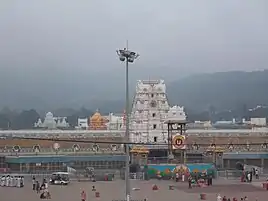
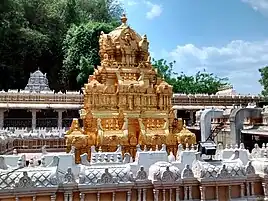 Kanaka Durga temple gopuram, Vijayawada
Kanaka Durga temple gopuram, Vijayawada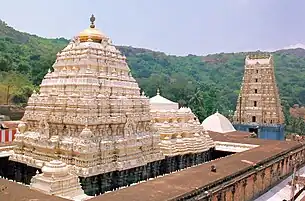
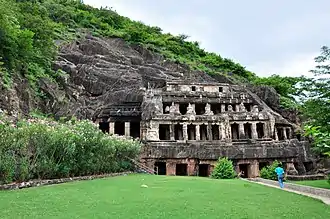
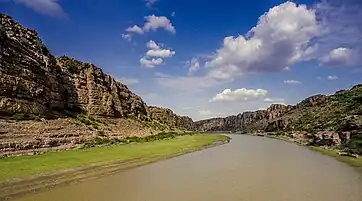 Gandikota canyon in Kadapa district
Gandikota canyon in Kadapa district
Some of the popular religious pilgrim destinations include Tirumala Venkateswara temple at Tirupati, Srikalahasti temple, Varaha Lakshmi Narasimha temple, Simhachalam, Shahi Jamia Masjid in Adoni, Gunadala Church in Vijayawada, and Buddhist centres at Amaravati and Nagarjuna Konda. Tirumala Venkateswara temple is the world's most visited Hindu temple, with footfalls of 30,000–40,000 daily and about 75,000 on New Year's Eve.[238] The region is home to a variety of other pilgrimage centres, such as the Pancharama Kshetras, Mallikarjuna Jyotirlinga, Kanaka Durga Temple and Kodanda Rama Temple. [239]
The state has several beaches in its coastal districts, such as Rushikonda, Mypadu, Suryalanka, etc.;[240] caves such as Borra Caves;[241] Indian rock-cut architecture depicting Undavalli Caves;[242] and the country's second-longest cave system, the Belum Caves.[243] The valleys and hills include Araku Valley, Horsley Hills, Papi Hills, and Gandikota Gorge.[244][245] Arma Konda, located in Visakhapatnam district, is the highest peak in the Eastern Ghats.[246]
Museums
The state has 32 museums,[247][lower-alpha 3] which feature a varied collection of ancient sculptures, paintings, idols, weapons, cutlery, inscriptions, and religious artefacts. The Amaravati Archaeological Museum has several archaeological artefacts.[248] Visakha Museum and Telugu Samskruthika Niketanam in Visakhapatnam display historical artefacts of the pre-independence era. Bapu Museum in Vijayawada displays a large collection of artefacts. Advanced projection mapping with graphic, animation, and laser displays is used to tell the history of Kondapalli Fort, utilising the irregular landscapes, ruins, and buildings present in the fort as a screen. It was launched in 2019.[249]
The Archaeological Survey of India identified 135 centrally protected monuments in the state of Andhra Pradesh. These include the reconstructed monuments at Anupu and Nagarjunakonda.[250]
Sports
The Sports Authority of Andhra Pradesh is the governing body that looks after the infrastructure development, coaching, and administration of sports promotion schemes.[251] Dr. YSR Sports School, with classes for grades 4–10 and a focus on tapping rural sports talent, was established in Putlampalli, YSR district, in December 2006.[252]
The ACA-VDCA stadium in Visakhapatnam hosted ODI, T20I, and IPL matches.[253] Andhra Pradesh secured 16 medals at the 36th National Games held in 2022. It was ranked twenty-first in the competition. It won the most medals in athletics. Two silvers and one bronze were won in weightlifting.[254]
Karnam Malleswari is the first female Indian to win an Olympic medal.[255] Pullela Gopichand is a former Indian badminton player. He won the All England Open Badminton Championships in 2001, becoming the second Indian to win after Prakash Padukone.[256][257] Srikanth Kidambi, a badminton player, is the first Indian to reach the world championships final in 2021 in the men's singles and win a silver medal.[258]
See also
Notes
References
- ↑ "Andhra celebrates Formation Day, CM hoists tricolour". Times of India. 1 November 2020.
- ↑ "Former Supreme Court judge Justice S Abdul Nazeer appointed as Governor of Andhra Pradesh". Bar and Bench. 12 February 2023. Retrieved 8 August 2023.
- ↑ Raghavendra, V. (30 November 2022). "Jawahar Reddy takes over as Chief Secretary of Andhra Pradesh". The Hindu. Retrieved 8 August 2023.
- 1 2 DOP 2023, p. 430.
- 1 2 3 4 5 6 7 8 DOP 2023, p. 3.
- 1 2 "AP Official Languages Act Amended to Recognise Urdu as Second Language". Sakshi Post. 7 March 2022. Archived from the original on 26 March 2022. Retrieved 31 October 2023.
- 1 2 Pavan (17 June 2022). "AP govt. issues orders recognising Urdu as the official language". The Hans India.
- 1 2 "Andhra Pradesh gets new state bird, state flower". Deccan Chronicle. 31 May 2018. Archived from the original on 1 June 2018. Retrieved 1 June 2018.
- ↑ "Andhra Pradesh". Lexico UK English Dictionary. Oxford University Press.
- ↑ ICLD 2014, p. 2.
- ↑ MOPNG 2023.
- ↑ "Harappan heritage of Andhra, I.Mahadevan" (PDF).
- 1 2 Ragini Devi (1990). Dance dialects of India. Motilal Bansarsi Dass. p. 66. ISBN 978-81-208-0674-0. Retrieved 9 June 2014.
- ↑ "History of Andhra Pradesh". Government of Andhra Pradesh. Archived from the original on 16 July 2012. Retrieved 22 July 2012.
- ↑ P. Raghunadha Rao (1993). Ancient and medieval history of Andhra Pradesh. Sterling Publishers, 1993. p. iv. ISBN 9788120714953. Retrieved 9 June 2014.
- ↑ Sailendra Nath Sen (1999). Ancient Indian history and civilization. New Age International. pp. 172–176. ISBN 9788122411980. Archived from the original on 23 March 2017. Retrieved 29 January 2017.
- ↑ Sudhakar Chattopadhyaya (1974). Some early dynasties of South India. Motilal Banarsidass. pp. 17–56. ISBN 9788120829411.
- ↑ Carla M. Sinopoli (2001). "On the edge of empire: Form and substance in the Satavahana dynasty". In Susan E. Alcock (ed.). Empires: Perspectives from archaeology and history. Cambridge University Press. pp. 166–168. ISBN 978-0-521-77020-0.
- ↑ "Struggle for Andhra state – AP state portal". Archived from the original on 15 June 2020. Retrieved 20 July 2020.
- ↑ Tiwari, Anshuman; Sengupta, Anindya (10 August 2018). Laxminama: Monks, merchants, money and mantra. Bloomsbury Publishing. p. 307. ISBN 9789387146808.
- ↑ Akira Shimada (2012). Early Buddhist architecture in context: The great stupa at Amaravati (ca. 300 BCE – 300 CE). BRILL. pp. 33–40. ISBN 978-90-04-23283-9. Archived from the original on 23 December 2016. Retrieved 14 October 2016.
- ↑ "Ananda Buddha Vihara". Archived from the original on 14 October 2007.
- ↑ Charles Higham (2009). Encyclopedia of ancient Asian civilizations. Infobase Publishing. p. 299. ISBN 978-1-4381-0996-1. Archived from the original on 9 June 2016. Retrieved 6 March 2016.
- ↑ Dutt, Sukumar (1988). Buddhist monks and monasteries of India: Their history and their contribution to Indian culture. Motilal Banarsidass. p. 132. ISBN 9788120804982.
- ↑ David M. Knipe (2015). Vedic voices: Intimate narratives of a living Andhra tradition. Oxford University Press. pp. 8–9. ISBN 978-0-19-026673-8. Archived from the original on 9 April 2017. Retrieved 14 October 2016.
- ↑ Padma, Sree. Barber, Anthony W. Buddhism in the Krishna river valley of Andhra. SUNY Press 2008, pg. 2.
- ↑ Davidson, Ronald. Tibetan renaissance. Columbia 2005, pp. 29.
- ↑ Subramanian, K. R. (1989). Buddhist remains in Andhra and the history of Andhra between 225 and 610 A.D. Asian Educational Services. ISBN 9788120604445.
- ↑ Sen, Sailendra Nath (1 January 1999). Ancient Indian history and civilization. New Age International. ISBN 9788122411980.
- ↑ R. Parthasarathy. Andhra culture: A petal in Indian lotus. Government of Andhra Pradesh, 1984. p. 40.
- ↑ "History: Satavahanas". Andhra Pradesh Government. Archived from the original on 8 April 2023. Retrieved 18 June 2023.
- ↑ "About Eastern Chalukyas – Official AP state government portal – AP state portal". Archived from the original on 17 June 2016. Retrieved 27 May 2016.
- ↑ Pollock, Sheldon, ed. (19 May 2003). Literary cultures in history: Reconstructions from South Asia. University of California Press. pp. 393, 397. ISBN 978-0-520-22821-4. Archived from the original on 5 April 2023. Retrieved 1 June 2023.
- ↑ "Imperial gazetteer of India, v. 15 1931". Kondaveedu. Digital South Asia Library. p. 393. Archived from the original on 13 June 2010. Retrieved 20 October 2009.
- ↑ Sewell, Robert (1884). Lists of inscriptions, and sketch of the dynasties of Southern India, Archaeological Survey of India. E. Keys at the Government Press. pp. 187–188. Retrieved 21 October 2009.
- ↑ "Kondavid-durg near Guntur. 19 February 1804. Signed 'W.R.'". British on line Gallery. Archived from the original on 18 October 2012. Retrieved 20 October 2009.
- ↑ Sewell, Robert; Nunes, Fernão; Paes, Domingos (1900). "Origin of the empire (A.D. 1336)". A forgotten empire (Vijayanagar): A contribution to the history of India. S. Sonnenschein & co ., ltd.
- ↑ Stein, Burton (1989). The New Cambridge History of India: Vijayanagara. Cambridge University Press. p. 88. ISBN 978-0-521-26693-2.
Controlling numerous villages and many large towns, these powerful chiefs commanded large mercenary armies that were the vanguard of Vijayanagara forces during the sixteenth century.
- ↑ B. A. Saletore (1930). Social and Political Life in the Vijayanagara Empire Vol II.
- ↑ "Andhra Pradesh eyes UNESCO tag for its heritage sites". 15 April 2017. Archived from the original on 4 December 2017. Retrieved 4 December 2017.
- ↑ "Lepakshi Nandi, Veerabhadra temple on UNESCO world heritage tentative list". The Hindu. 29 March 2022. Archived from the original on 1 December 2022. Retrieved 30 May 2023.
- ↑ Richards, J. F. (1975). "The Hyderabad Karnatik, 1687–1707". Modern Asian Studies. 9 (2): 241–260. doi:10.1017/S0026749X00004996. S2CID 142989123.
- ↑ Wheeler 1996, p. 26.
- ↑ "Imperial gazetteer of India v. 24, p. 339". Archived from the original on 4 June 2023. Retrieved 31 May 2023.
- ↑ "Shocking Truth". Time. 10 February 1947. Archived from the original on 2 September 2009.
- ↑ Hope, Elizabeth (1900). General Sir Arthur Cotton, R. E., K. C. S. I.: His life and work. London: Hodder and Stoughton. p. 120. ISBN 978-1444629965. Retrieved 26 December 2018.
dowleswaram.
- ↑ Peter L. Schmitthenner (2001). Telugu resurgence: C.P. Brown and cultural consolidation in nineteenth-century South India. Manohar. p. 94. ISBN 978-81-7304-291-1.
- ↑ "Kandukuri, A great reformer, remembered on his death centenary| Countercurrents". 27 May 2019. Archived from the original on 18 January 2022. Retrieved 16 January 2022.
- ↑ Gudipoodi, Srihari (27 September 2012). "Remembering the immortal satirist". The Hindu. Archived from the original on 17 August 2021. Retrieved 16 June 2022.
- ↑ "Post-independence era, then and now". aponline.gov.in. Archived from the original on 20 December 2013. Retrieved 3 August 2013.
- ↑ "P.V. Narasimha Rao". Encyclopedia Britannica. 17 May 2023. Archived from the original on 2 June 2023. Retrieved 1 June 2023.
- ↑ "N.T. Rama Rao: A timeline". The Hindu. 28 May 2017. Archived from the original on 1 June 2023. Retrieved 1 June 2023.
- ↑ Vaddiraju, Anil kumar (21 March 2020). "The mandal System in Telangana and Andhra Pradesh" (PDF). Economic & Political Weekly. LV (12). Archived (PDF) from the original on 1 June 2023. Retrieved 1 June 2023.
- ↑ "KTR's admission: Chandrababu Naidu helped IT grow in Hyderabad". Economic Times. 15 December 2017. Archived from the original on 1 June 2023. Retrieved 1 June 2023.
- ↑ PTI (3 September 2009). "YSR: From aggressive politician to mass leader". The Hindu. Retrieved 20 June 2023.
- ↑ "Bitter memories". Hinduonnet.com. Archived from the original on 22 January 2010. Retrieved 14 September 2010.
{{cite news}}: CS1 maint: unfit URL (link) - ↑ "TJAC leaders to knock on Prez and PM's doors". The Times of India. 30 September 2011. Archived from the original on 3 January 2013. Retrieved 5 March 2014.
- ↑ Maheshwari, R. Uma (31 July 2013). "A state that must fulfil a higher purpose". The Hindu. ISSN 0971-751X. Archived from the original on 20 July 2020. Retrieved 20 July 2020.
- ↑ Jayaprakash Narayan (28 October 2013). "A challenge to Indian federalism". The Hindu. Retrieved 20 June 2023.
- ↑ "Telangana state formation gazette". The New Indian Express. Archived from the original on 6 July 2014. Retrieved 14 May 2014.
- ↑ "CBN to be sworn as CM of Andhra on June 8th". Deccan-Journal. Archived from the original on 14 July 2014. Retrieved 2 June 2014.
- ↑ "Andhra Pradesh to get new capital Amaravati today, PM Modi to inaugurate". NDTV. 22 October 2015. Archived from the original on 14 April 2021. Retrieved 9 March 2021.
- ↑ P, Ashish (2 March 2017). "Chief Minister Chandrababu Naidu inaugurates new Andhra Pradesh assembly". India Today. Archived from the original on 14 April 2021. Retrieved 9 March 2021.
- 1 2 "Explained : The stalemate between Telangana and AP". The Hindu. 10 January 2023. Archived from the original on 29 May 2023. Retrieved 29 May 2023.
- 1 2 "Explained : The Telangana- Andhra Pradesh water dispute". The Hindu. 23 May 2023. Archived from the original on 29 May 2023. Retrieved 29 May 2023.
- ↑ "Political map of India 1:4000000 (10th edition)". Survey of India. 1 January 2020. Archived from the original on 10 April 2023. Retrieved 16 June 2023.
- ↑ "Kadapa or Cuddapah basin". Directorate General of Hydrocarbons. Archived from the original on 26 April 2023. Retrieved 2 June 2023.
- ↑ DES 2021, p. 107.
- ↑ Chapter 13: Forests and tree resources in states and union territories (PDF). 2021. pp. 257–264. Archived (PDF) from the original on 2 June 2023. Retrieved 2 June 2023.
- 1 2 "Natural vegetation and wildlife". AP Forest Department. Archived from the original on 4 July 2014. Retrieved 6 June 2014.
- ↑ "Coringa sanctuary". East godavari district, Government of AP. Archived from the original on 2 June 2023. Retrieved 2 June 2023.
- ↑ "The list of wetlands of international importance" (PDF). The Ramsar convention on wetlands. The Secretariat of the Convention on Wetlands (Ramsar, Iran, 1971). p. 20. Archived (PDF) from the original on 30 May 2012. Retrieved 5 June 2014.
- ↑ "Industrial & fertilizer minerals" (PDF). Geological Survey of India portal. CGPB Committee-IV. pp. 17–44. Archived from the original (PDF) on 16 October 2013. Retrieved 9 June 2014.
- ↑ "India: 'Massive' uranium find in Andhra Pradesh". New Delhi: BBC World News. 19 July 2011. Retrieved 19 July 2011.
- ↑ Ganguly, Nivedita (17 September 2014). "Lambasingi set to become tourist hotspot". The Hindu. Visakhapatnam. Archived from the original on 3 September 2015. Retrieved 26 November 2014.
- ↑ "Lambasingi records 2º c". Deccan Chronicle. Visakhapatnam. 16 December 2013. Archived from the original on 13 July 2015. Retrieved 26 November 2014.
- 1 2 DES 2021, p. 31.
- ↑ DOP 2023, p. 16.
- ↑ Population in different age group - Census 2011 (PDF). MHRD. p. 3. Archived (PDF) from the original on 10 October 2022. Retrieved 28 May 2023.
- ↑ "Sub-national HDI – area database". Global Data Lab. Institute for Management Research, Radboud University. Archived from the original on 23 September 2018. Retrieved 14 July 2021.
- ↑ "A.P. has 3,99,84,868 voters, women outnumber men". The Hindu. 5 January 2023. Archived from the original on 28 May 2023. Retrieved 28 May 2023.
- 1 2 "Table C-16 Population by mother tongue: Andhra Pradesh". Census of India. Registrar General and Census Commissioner of India. Archived from the original on 12 November 2022. Retrieved 4 January 2023.
- ↑ "Telugu language". AP State Portal. Government of India. Archived from the original on 19 June 2015. Retrieved 19 June 2015.
- ↑ "Report of the commissioner for linguistic minorities: 47th report (July 2008 to June 2010)" (PDF). Commissioner for Linguistic Minorities, Ministry of Minority Affairs, Government of India. pp. 122–126. Archived from the original (PDF) on 13 May 2012. Retrieved 16 February 2012.
- ↑ "AP recognises Urdu as second official language". Deccan Chronicle. 17 June 2022.
- ↑ "Andhra Pradesh | History, capital, population, map, & points of interest". Encyclopedia Britannica. Archived from the original on 13 April 2020. Retrieved 7 April 2020.
- ↑ Indian readership survey 2019 Q4 (PDF). IRS. 2020. p. 20. Archived (PDF) from the original on 25 September 2020. Retrieved 27 May 2023.
- 1 2 "Population by religion - Andhra Pradesh". censusindia.gov.in. Registrar General and Census Commissioner of India. 2011. Archived from the original on 28 May 2022. Retrieved 4 January 2023.
- ↑ International Institute for Population Sciences (IIPS) and ICF (2021). National family health survey (NFHS-5), India, 2019-21: Andhra Pradesh (PDF). Mumbai: IIPS. Archived (PDF) from the original on 2 June 2023. Retrieved 2 June 2023.
- ↑ "Andhra Pradesh: development eludes North Andhra region despite rich in natural resources, say leaders of various political parties". The Hindu. 7 January 2023. Archived from the original on 13 January 2023. Retrieved 16 June 2023.
- ↑ "Population of AP districts (2011)". ap.gov.in. p. 14. Archived from the original on 17 March 2015. Retrieved 25 May 2014.
- 1 2 DOP 2023, p. 431.
- ↑ Monthly bulletin (PDF). Ministry of Panchayat raj, Government of India. 2022. p. 3. Archived (PDF) from the original on 3 June 2023. Retrieved 3 June 2023.
- ↑ DOP 2023, p. 18.
- 1 2 "Andhra Pradesh (India): State, major agglomerations & cities – Population statistics, maps, charts, weather and web information". Citypopulation.de. Archived from the original on 21 October 2018. Retrieved 7 September 2020.
- 1 2 3 4 "Andhra Pradesh budget analysis 2023-24". PRSINDIA. Archived from the original on 28 May 2023. Retrieved 28 May 2023.
- ↑ M, Sambasiva Rao (16 March 2023). "Andhra Pradesh posts a growth of 16.22% over the previous year". The Hindu. Archived from the original on 25 March 2023. Retrieved 25 March 2023.
- ↑ "Indian states by GDP". Statistics Times. Archived from the original on 16 February 2016. Retrieved 21 February 2016.
{{cite web}}: CS1 maint: unfit URL (link) - ↑ DOP 2015, p. 17.
- ↑ "United AP stood second in agri exports". The Hindu. Vijayawada. 17 January 2016. Archived from the original on 17 January 2016. Retrieved 17 January 2016.
- ↑ DES 2021, p. 127.
- ↑ "AP top producer of shrimp: MPEDA". The Hindu. 16 January 2013. Archived from the original on 28 February 2013. Retrieved 9 June 2014.
- ↑ "Vannamei hatcheries". Coastal Aquaculture Authority. Archived from the original on 3 June 2014. Retrieved 16 July 2014.
- ↑ Annual survey of industries (PDF). DES, GOAP. 2020. Retrieved 26 May 2023.
- ↑ "Ship building division". Hindustan Shipyard Limited. Archived from the original on 6 July 2014. Retrieved 6 August 2014.
- ↑ "Firms in Sricity". Sricity.in. Archived from the original on 9 May 2015. Retrieved 14 May 2015.
- ↑ "Auto, automobiles & EV". APEDB. Archived from the original on 26 May 2023. Retrieved 26 May 2023.
- ↑ DOP 2023, p. 9.
- ↑ "Cairn India operations - Andhra Pradesh". Cairn India. Archived from the original on 26 May 2023. Retrieved 26 May 2023.
- ↑ MOPNG 2023, p. 31.
- ↑ MOPNG 2023, p. 33.
- ↑ "Andhra Pradesh's share in IT exports is below 0.2%, says union minister". The Hindu. 5 April 2023. Archived from the original on 24 May 2023. Retrieved 24 May 2023.
- ↑ "AP ranked 3rd, Telangana 6th in domestic tourist footfalls". Deccan Chronicle. 5 December 2022. Archived from the original on 26 May 2023. Retrieved 26 May 2023.
- ↑ "Andhra Pradesh legislative assembly". Archived from the original on 1 April 2005.
- ↑ "Delimitation of parliamentary and assembly constituencies order, 2008" (PDF). Election Commission of India. pp. 16–28. Archived (PDF) from the original on 5 October 2010. Retrieved 11 October 2014.
- ↑ "Overview". AP Legislature. Government of Andhra Pradesh. Archived from the original on 19 May 2015. Retrieved 23 May 2015.
- ↑ "Andhra Pradesh Assembly Election 2019 Detailed Results". Archived from the original on 20 March 2020.
- ↑ "Andhra Pradesh witnesses an upswing in revenue earned through registration and stamps department". The Hindu. 2 December 2022. Archived from the original on 26 May 2023. Retrieved 26 May 2023.
- ↑ "AP Govt's debt mounts to ₹3.89 lakh crore in FY22". Businessline. 13 March 2022. Archived from the original on 28 May 2023. Retrieved 28 May 2023.
- ↑ "YS Jaganmohan Reddy's three-capital plan on track as Andhra Pradesh governor gives nod to two bills". Archived from the original on 1 August 2020. Retrieved 1 August 2020.
- ↑ Sudhir, Uma (13 January 2020). "Won't celebrate harvest festival, say Amaravati farmers amid protests". NDTV. Archived from the original on 14 April 2021. Retrieved 28 February 2021.
- ↑ "Andhra Pradesh withdraws controversial 3-capital bill". NDTV.com. Archived from the original on 22 November 2021. Retrieved 22 November 2021.
- ↑ "Andhra Pradesh: Support pours in for padyatra by Amaravati farmers". Siasat. 14 September 2022. Archived from the original on 25 April 2023. Retrieved 25 April 2023.
- ↑ "Capital verdict: On A.P. high court judgment on Amaravati". The Hindu. 5 March 2022. Archived from the original on 26 April 2023. Retrieved 25 April 2023.
- ↑ Raghavendra, V. (12 July 2023). "Three capitals case: Supreme Court adjourns hearing of SLP filed by A.P. govt. to December". The Hindu. Retrieved 14 August 2023.
- ↑ "Andhra Pradesh objects to Telangana's project on Godavari river". TOI. 30 January 2023. Archived from the original on 29 May 2023. Retrieved 29 May 2023.
- ↑ "Explained : Dispute between Telangana and Andhra Pradesh over flooding of Bhadrachalam". The Hindu. 20 June 2022. Archived from the original on 29 May 2023. Retrieved 29 May 2023.
- ↑ DOP 2023, p. 168.
- ↑ "Anantapur-Guntur national highway gets govt's nod". TOI. 14 December 2022. Archived from the original on 21 May 2023. Retrieved 21 May 2023.
- ↑ DOP 2023, p. 173.
- ↑ DOP 2023, p. 174-175.
- ↑ DOP 2023, p. 175.
- ↑ DOP 2023, p. 176.
- ↑ "PNBS to come under surveillance". The Hindu. 23 May 2013. Archived from the original on 18 May 2021. Retrieved 16 June 2023.
- ↑ Indian railways year book 2021-22 (PDF). Indian Railways. 2022. p. 62. Archived (PDF) from the original on 18 April 2023. Retrieved 19 May 2023.
- ↑ "State-wise route kilometerage". South Central Railway. Archived from the original on 6 February 2011. Retrieved 23 April 2017.
- ↑ "South Western Railway - divisions". South Western railway. Archived from the original on 24 April 2023. Retrieved 24 April 2023.
- ↑ "East coast railway divisions". East coast railway. Retrieved 24 April 2023.
- ↑ IR 2022, p. 5.
- ↑ IR 2022, p. 29.
- ↑ "Statement showing category-wise no. of stations" (PDF). South Central Railway. Archived (PDF) from the original on 28 January 2016. Retrieved 23 April 2017.
- ↑ "Vizag billed the cleanest rail station". The Hindu. 18 May 2017. ISSN 0971-751X. Archived from the original on 4 January 2018. Retrieved 4 January 2018.
- ↑ Bhattacharjee, Sumit. "Hidden 100 – 58 tunnels. 84 bridges. Welcome to Araku Valley". The Hindu. Archived from the original on 9 June 2017. Retrieved 23 April 2017.
- ↑ "Cabinet approves South Coast railway zone". Press Information Bureau. Archived from the original on 2 April 2019. Retrieved 12 February 2022.
- ↑ DOP 2023, p. 180-183.
- ↑ "Puttaparthi airport to facilitate emergency landings; security to be beefed up". Deccan Chronicle. 25 July 2021. Retrieved 10 August 2021.
- ↑ DOP 2023, p. 183.
- ↑ "Vizag port info". vizagport. Archived from the original on 11 November 2012. Retrieved 9 June 2014.
- ↑ "Capacity of port". gangavaram port. Archived from the original on 21 February 2014. Retrieved 9 June 2014.
- ↑ DOP 2023, p. 195.
- ↑ DOP 2023, p. 204.
- ↑ "AP Fiber Grid Vision". apsfl.in. Archived from the original on 31 October 2018. Retrieved 31 October 2018.
- ↑ "Water resources department - History". Water resources department. Archived from the original on 30 May 2023. Retrieved 30 May 2023.
- ↑ "Dam design review panel approves repairs to Polavaram diaphragm wall damaged in Godavari floods". The Hindu. 5 March 2023. Archived from the original on 30 May 2023. Retrieved 30 May 2023.
- ↑ "Veligonda project may be inaugurated in September". The Times of India. 10 January 2023. Archived from the original on 30 May 2023. Retrieved 30 May 2023.
- ↑ "Rs 787 crore sanctioned by Andhra for makeover of Annamayya". Times of India. 4 November 2022. Archived from the original on 30 May 2023. Retrieved 30 May 2023.
- ↑ "Andhra Pradesh Budget: Rs 11,908 crore to develop irrigation with focus on pending projects". The New Indian Express. 17 March 2023. Archived from the original on 30 May 2023. Retrieved 30 May 2023.
- ↑ Power development in Andhra Pradesh (Statistics) 2021-22 (PDF). 2022. pp. 1–2.
- ↑ "AP govt spending 7.3 pc of state budget on healthcare, says top official". Siasat. 11 May 2023. Archived from the original on 2 June 2023. Retrieved 2 June 2023.
- ↑ Vanam, Jwala Narasimha Rao (4 July 2022). "108 & 104 totally dissimilar services". The hansindia. Archived from the original on 2 June 2023. Retrieved 2 June 2023.
- ↑ Singh, P.; Powell, A. C. (2022). "Utilization trends of a government-sponsored health insurance program in South India: 2014 to 2018". Value in Health Regional Issues. 27: 82–89. doi:10.1016/j.vhri.2021.02.007. PMID 34844063. S2CID 244706313.
- ↑ "School education department" (PDF). Rashtriya Madhyamik Shiksha Abhiyan. Hyderabad: School Education Department, Government of Andhra Pradesh. 26 March 2015. Archived from the original (PDF) on 19 March 2016. Retrieved 6 June 2019.
- ↑ "The department of school education – Official AP state government portal". ap.gov.in. Archived from the original on 13 April 2017. Retrieved 7 November 2016.
- ↑ Nagaraju, M.T.V (2004). Study habits of secondary school students. Discovery Publishing House. p. 75. ISBN 978-81-7141-893-0. Retrieved 14 March 2016.
- ↑ "Student information day wise status report". Commissionerate of School Education. Archived from the original on 6 June 2019. Retrieved 6 June 2019.
- ↑ "School information". Commissionerate of School Education. Archived from the original on 6 June 2019. Retrieved 6 June 2019.
- ↑ "Girls outperform boys by over 6% in SSC exams in Andhra Pradesh". 6 May 2023. Archived from the original on 19 May 2023. Retrieved 17 June 2023.
- ↑ "Girls dominate boys in AP Intermediate 1 & 2 results". Deccan chronicle. 27 April 2023. Archived from the original on 9 May 2023. Retrieved 17 June 2023.
- ↑ DOP 2023, p. 12.
- ↑ "Andhra Pradesh first state to adopt CBSE system for government run schools". Times of India. 7 November 2022. Archived from the original on 25 April 2023. Retrieved 25 April 2023.
- ↑ "Andhra schools' transition from Telugu to English medium has roots in the far past". The federal. 19 May 2022. Archived from the original on 25 April 2023. Retrieved 25 April 2023.
- ↑ Program appriasal document -SALT (PDF). World Bank. 20 May 2021. Archived (PDF) from the original on 25 April 2023. Retrieved 25 April 2023.
- ↑ Transforming industrial training institutes (PDF). Niti Ayog. 2023. p. 30. Archived (PDF) from the original on 20 April 2023. Retrieved 17 June 2023.
- ↑ DOP 2023, p. 13-14.
- ↑ "AP State Council for Higher Education home page". APSCHE. Archived from the original on 25 April 2023. Retrieved 25 April 2023.
- ↑ "AP State Skill Development Corporation - Home". APSSDC. Archived from the original on 28 January 2023. Retrieved 22 May 2023.
- ↑ UGC 2021, p. 100.
- ↑ Correspondent, Special. "Old-timers recollect glorious days of AU". The Hindu. Archived from the original on 14 February 2021. Retrieved 2 May 2017.
- ↑ "Statistical profile of universities in Andhra Pradesh" (PDF). Andhra Pradesh State Council of Higher Education. Archived from the original (PDF) on 22 December 2017. Retrieved 13 May 2017.
- ↑ "Rajiv Gandhi University of Knowledge Technologies". Rgukt.in. Archived from the original on 7 October 2011. Retrieved 8 October 2011.
- ↑ "Dr. Y.S.R University of Health Sciences (NUHS)". Department of health, medical and family welfare, Government of Andhra Pradesh. Archived from the original on 27 February 2020. Retrieved 2 June 2023.
- ↑ Bhattacharjee, Sumit (2 June 2023). "A.P. Spotlight | The slow descent of state-run varsities into oblivion in Andhra Pradesh". The Hindu. Archived from the original on 2 June 2023. Retrieved 2 June 2023.
- ↑ UGC 2021, p. 93.
- ↑ "NIRF Rankings: only two institutions from Andhra Pradesh figure in top 100 educational institutions". The Hindu. 5 June 2023. Archived from the original on 12 June 2023. Retrieved 17 June 2023.
- ↑ B, Deenadhayalu (5 June 2021). "Public library system in Andhra Pradesh: An overview". Library Philosophy and Practice. University of Nebraska - Lincoln.
- ↑ "This 100-year-old library loses its patrons as Internet spreads reach". The New Indian Express. 31 December 2018. Retrieved 19 June 2023.
- ↑ "Digital libraries yet to materialise despite funding". The Hans India. 19 November 2022. Retrieved 19 June 2023.
- ↑ "List of S&T organisations". India science, technology and innovation. Vigyan Prasar, Department of science and technology, Government of India. Retrieved 20 June 2023.
- ↑ "SHAR". Archived from the original on 27 September 2013. Retrieved 15 May 2014.
- ↑ "Chandrayaan 1". Archived from the original on 8 February 2014. Retrieved 15 May 2014.
- ↑ Maruyama, Koscak (1 March 1991). "The discovery of adenosine triphosphate and the establishment of its structure". Journal of the History of Biology. 24 (1): 145–154. doi:10.1007/BF00130477. S2CID 87425890. Archived from the original on 15 April 2023. Retrieved 3 June 2023.
- ↑ Mukherjee, Siddhartha (2010). The emperor of all maladies: A biography of cancer. Simon and Schuster. p. 31. ISBN 978-1-4391-0795-9. Retrieved 6 September 2011.
- ↑ Joseph H Hulse (1 October 1985). "Professor Yelavarthy Nayudamma : A grateful appreciation of a dear friend" (PDF). IDRC. Archived from the original (PDF) on 8 October 2007. Retrieved 14 June 2007.
- ↑ Prakasa Rao, B. L. S. (10 September 2014). "C. R. Rao: A life in statistics" (PDF). Current Science. Archived (PDF) from the original on 31 October 2017. Retrieved 17 February 2020.
- ↑ Press in India 2020-21 Chapter 9: Press in states and union territories (PDF). RNI. 2021. p. 524. Archived (PDF) from the original on 28 May 2023. Retrieved 27 May 2023.
- ↑ Dudekula, Dastagiri; KVN, Rajeswara Rao; Kopparthi, Adisesu (2018). "Telugu newspapers and periodicals in Andhra Pradesh and Telangana states: A study" (PDF). International Journal of Library and Information Studies. 8 (4). ISSN 2231-4911.
- ↑ "Highest circulated dailies, weeklies & magazines amongst member publications (across languages)" (PDF). Auditbureau. Archived (PDF) from the original on 8 April 2023. Retrieved 8 March 2023.
- ↑ KT, Naheem; M, Saraswati Rao (2017). "Webometric analysis of Telugu news paper websites: An evaluative study using Alexa Internet". International Journal of Digital Library Services. 7 (2). ISSN 2250-1142.
- ↑ "BBC to launch Telugu news website". The Hindu. 10 December 2016. Retrieved 19 June 2023.
- ↑ "BBC News తెలుగు: ఒక ఏడాది.. కొన్ని అనుభవాలు" (in Telugu). BBC. 2 October 2018. Retrieved 19 June 2023.
- ↑ "Andhra Pradesh: Tussle between media houses takes political colour". Hindustan Times. 27 April 2023. Archived from the original on 27 May 2023. Retrieved 27 May 2023.
- ↑ "Warning to media by Andhra Pradesh government: Is it a caste rivalry?". The Telegraph. 21 October 2019. Archived from the original on 27 May 2023. Retrieved 27 May 2023.
- ↑ "I & PR approved rates towards telecast of TV spots and Scrolls". IPR, AP Government. Archived from the original on 26 March 2023. Retrieved 27 May 2023.
- ↑ "Radio rates" (PDF). IPR, Government of AP. Archived (PDF) from the original on 27 May 2023. Retrieved 27 May 2023.
- ↑ Annual report 2021-22 Intellectual property India (PDF). The Office of the controller general of patents, designs and geographical indications, Government of India. 2022. p. 76. Archived (PDF) from the original on 30 May 2023. Retrieved 30 May 2023.
- 1 2 "State wise registration details of G.I applications (15th September, 2003 – till date)" (PDF). Geographical Indication Registry. p. 1. Archived (PDF) from the original on 18 September 2017. Retrieved 5 May 2017.
- ↑ "Banaganapalle mangoes finally get GI tag". deccanchronicle.com/. 4 May 2017. Archived from the original on 5 May 2017. Retrieved 13 May 2017.
- ↑ Naidu, T. Appala. "Bandar laddu gets GI tag". The Hindu. Archived from the original on 12 November 2020. Retrieved 13 May 2017.
- ↑ "Kalamkari: Craft of the matter". mid-day. 24 August 2015. Archived from the original on 31 January 2016. Retrieved 26 January 2016.
- ↑ "Durgi stone craft". Cesdeva. Archived from the original on 4 December 2013. Retrieved 20 December 2013.
- ↑ "Lacquer ware toys". Lepakshi handicrafts. Archived from the original on 30 May 2023. Retrieved 30 May 2023.
- ↑ Sarma, Rani (20 December 2015). "The lac industry of Etikoppaka – An art form to cherish". The Times of India. Archived from the original on 25 December 2015. Retrieved 11 March 2016.
- ↑ Gopavaram, Padmapriya; Subrahmanyam, Korada (2011). "1". A comparative study of Andhrasabdachintamani and Balavyakaranam. Hyderabad: University of Hyderabad.
- ↑ Proceedings of the Andhra Pradesh oriental conference, first session, Andhra Saraswatha Parishat, Hyderabad, May 1977. The Conference. 1979. p. 131. Archived from the original on 9 May 2023. Retrieved 2 June 2023.
Kalagnana is a special type of discipline very popular in Andhra Desa because of the famous Kalagnanam of Sri Potuluri Veerabrahmendhra swami written in Telugu. It forecasts many incidents which are proved to be correct by the posterity.
- ↑ Yogendra K. Malik (1981). South Asian intellectuals and social change: A study of the role of vernacular-speaking intelligentsia. Heritage. p. 314. ISBN 9780836408256.
A later poet similar to Vemana was Potuluri Veerabrahmendhra swami , popularly known as Brahmamgaru
- ↑ GK, Subbarayudu; C, Vijayasree (1996). "Twentieth-century Telugu literature". In Nalini Natarajan (ed.). Handbook of twentieth-century literatures of India. Greenwoord press. Archived from the original on 14 January 2021. Retrieved 30 May 2023.
- ↑ Ganguli, Nivedita (12 January 2023). "Festive flavours of Sankranti in Andhra Pradesh". The Hindu. Archived from the original on 2 June 2023. Retrieved 2 June 2023.
- ↑ "Festivals and Fairs of Andhra Pradesh". AP Tourism. Retrieved 5 October 2023.
- ↑ "Special prayers mark Ramzan". The Hindu. 8 July 2016. Archived from the original on 2 June 2023. Retrieved 2 June 2023.
- ↑ "Stage set for Rottela panduga". www.deccanchronicle.com. Archived from the original on 6 December 2011.
- ↑ Manorma Sharma (2007). Musical heritage of India. APH. pp. 19–32. ISBN 978-81-313-0046-6.
- ↑ Thoomati Donappa. Telugu harikatha sarvasvam. OCLC 13505520.
- ↑ "Burrakatha loses sheen sans patronage". The Times of India. 14 January 2013. Archived from the original on 2 April 2015. Retrieved 2 September 2013.
- ↑ "Nandi natakotsavam awards". India Scanner. 8 October 2010. Archived from the original on 17 March 2012. Retrieved 13 October 2012.
- ↑ 20th century Telugu luminaries, Potti Sriramulu Telugu University, Hyderabad, 2005
- ↑ Narasimham, M. L. (7 November 2010). "Sati Savithri (1933)". The Hindu. Archived from the original on 13 November 2010. Retrieved 8 July 2011.
- ↑ Bhagwan Das Garg (1996). So many cinemas: the motion picture in India. Eminence Designs. p. 86. ISBN 978-81-900602-1-9. Archived from the original on 21 May 2016. Retrieved 17 February 2017.
- ↑ "AP state film television and theatre development corporation". APSFTVTDC. Archived from the original on 4 April 2023. Retrieved 30 May 2023.
- ↑ "Film hub: Focus on Vizag again". Thehansindia. 17 February 2022. Archived from the original on 30 May 2023. Retrieved 30 May 2023.
- ↑ Reddem, Appaji (5 March 2022). "Is Telugu cinema set for a change of scene?". The Hindu. Retrieved 23 June 2023.
- ↑ Ramakrishnan, Sathyalaya (11 September 2010). "Prestigious 'Phalke" award conferred to veteran film producer D Rama Naidu". Asian Tribune. Archived from the original on 23 May 2012. Retrieved 8 October 2011.
- ↑ "Tollywood loses to Bollywood on numbers". The Times of India. 2 October 2010. Archived from the original on 13 July 2015. Retrieved 31 January 2014.
- ↑ "Telugu film industry enters new era". Business Line. 6 November 2007. Archived from the original on 3 February 2014. Retrieved 31 January 2014.
- ↑ "Oscars 2023: RRR's 'Naatu Naatu' wins best original song at the 95th Academy Awards, MM Keeravani sings ode to India on stage". Indian Express. 13 March 2023. Archived from the original on 13 March 2023. Retrieved 13 March 2023.
- ↑ "Oscars 2023: RRR's Naatu Naatu wins best original song". BBC News. 13 March 2023. Archived from the original on 13 March 2023. Retrieved 13 March 2023.
- ↑ APTDC 2019, p. 54–63.
- ↑ "Andhra cuisine: A symphony of spices". Indianculture.gov.in. Archived from the original on 29 May 2023. Retrieved 29 May 2023.
- ↑ "Most visited Hindu temple". Guinness world records. Retrieved 19 June 2023.
- ↑ APTDC 2019, p. 18–25.
- ↑ "Andhra Pradesh to develop beach front locations". The Times of India. Archived from the original on 13 December 2016. Retrieved 13 May 2017.
- ↑ Bhattacharjee, Sumit. "Natural world heritage status for Borra Caves sought". The Hindu. Archived from the original on 16 January 2017. Retrieved 13 May 2017.
- ↑ "Welcome to Guntur district official website". Archived from the original on 27 June 2016. Retrieved 31 May 2016.
- ↑ "Film tourism to boost Kurnool economy". deccanchronicle.com/. 3 February 2017. Archived from the original on 13 March 2017. Retrieved 13 May 2017.
- ↑ "Tourist destinations in AP". Andhra Pradesh Tourism Department. Archived from the original on 6 August 2010. Retrieved 5 June 2014.
- ↑ APTDC 2019, p. 67-75.
- ↑ "Arma Konda, India". peakbagger. Archived from the original on 5 January 2023. Retrieved 17 June 2023.
- ↑ Directory of museums in India. Ministry of culture, Government of India. 2023. pp. 1–29.
- ↑ "Archaeological museum, Amaravati – Archaeological Survey of India". Asi.nic.in. Archived from the original on 29 September 2011. Retrieved 19 August 2010.
- ↑ "Visitor footfall picks up at Kondapalli Fort post-renovation". The Hindu. 20 February 2019. Archived from the original on 16 July 2021. Retrieved 17 June 2023.
- ↑ "Alphabetical list of monuments – Andhra Pradesh". Archaeological Survey of India. Archived from the original on 30 November 2022. Retrieved 24 May 2023.
- ↑ "Sports authority of Andhra Pradesh". SAAP. Retrieved 28 May 2022.
- ↑ "Home page of Dr YSR Sports school". Dr YSR sports school, Sports authority of Andhra Pradesh. Retrieved 20 June 2023.
- ↑ "ACA-VDCA Stadium". Board of Control for Cricket in India. Retrieved 24 April 2023.
- ↑ "National games: AP settles with 16 medals, 21st rank". The Hindu. 12 October 2022. Archived from the original on 28 May 2023. Retrieved 28 May 2023.
- ↑ Ganguly, Meenakshi (27 December 2000). "Conversations: 'I did what I could for my country'". Time. Archived from the original on 5 January 2013.
- ↑ "Pulella Gopichand". mapsofindia.com. Archived from the original on 13 February 2009. Retrieved 7 February 2010.
- ↑ "P Gopichand". The Times of India. 11 December 2002. Archived from the original on 21 August 2009. Retrieved 7 February 2010.
- ↑ "Srikanth Srikanth Kidambi". Olympics. Archived from the original on 28 October 2022. Retrieved 28 October 2022.
Bibliography
- APTDC (2019). Andhra Pradesh main book. Andhra Pradesh Tourism. Archived from the original on 31 March 2023. Retrieved 17 June 2023.
- DES (2021). Agricultural statistics at a glance 2020-21 Andhra Pradesh (PDF). DES, Government of Andhra Pradesh.
- DOP (2015). AP Socio economic survey 2014-15; Chapter 2: Macro economic aggregates (PDF). Archived from the original (PDF) on 1 July 2015.
- DOP (2023). Socio economic survey 2022-23 (PDF). Government of AP.
- ICLD (2014). The Andhra Pradesh reorganisation act, 2014 (PDF). Ministry of Law and Justice. Archived from the original (PDF) on 24 September 2015. Retrieved 14 July 2015.
- IR (2022). New railways New Andhra Pradesh 2014-2022 (PDF). Archived (PDF) from the original on 13 August 2022. Retrieved 19 May 2023.
- MOPNG (2023). Indian PNG statistics (PDF). Ministry of petroleum and natural gas, India. Archived (PDF) from the original on 26 May 2023. Retrieved 26 May 2023.
- UGC (2021). Annual report 2020-21 (PDF). UGC. Archived (PDF) from the original on 22 May 2023. Retrieved 22 May 2023.
- Wheeler, James Talboys (1996). Madras in the Olden Time: Being a History of the Presidency from the First Foundation of Fort St. George to the Occupation of Madras by the French (1639–1748). Asian Educational Services. ISBN 8120605535.
External links
Government
General information
- Andhra Pradesh at Curlie
 Geographic data related to Andhra Pradesh at OpenStreetMap
Geographic data related to Andhra Pradesh at OpenStreetMap


